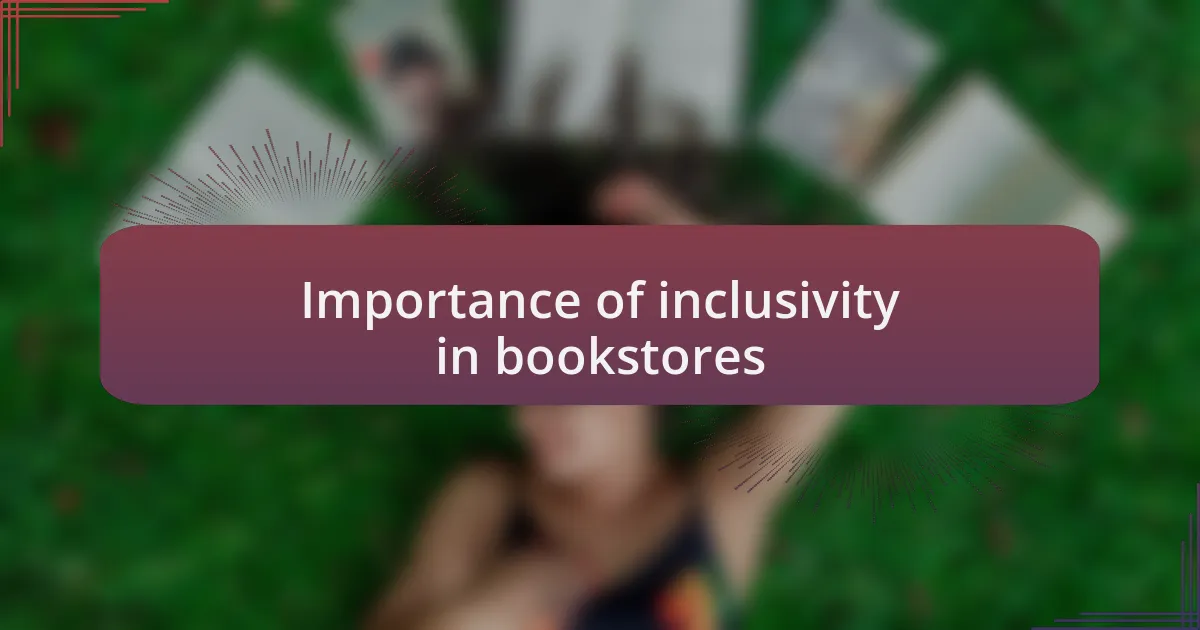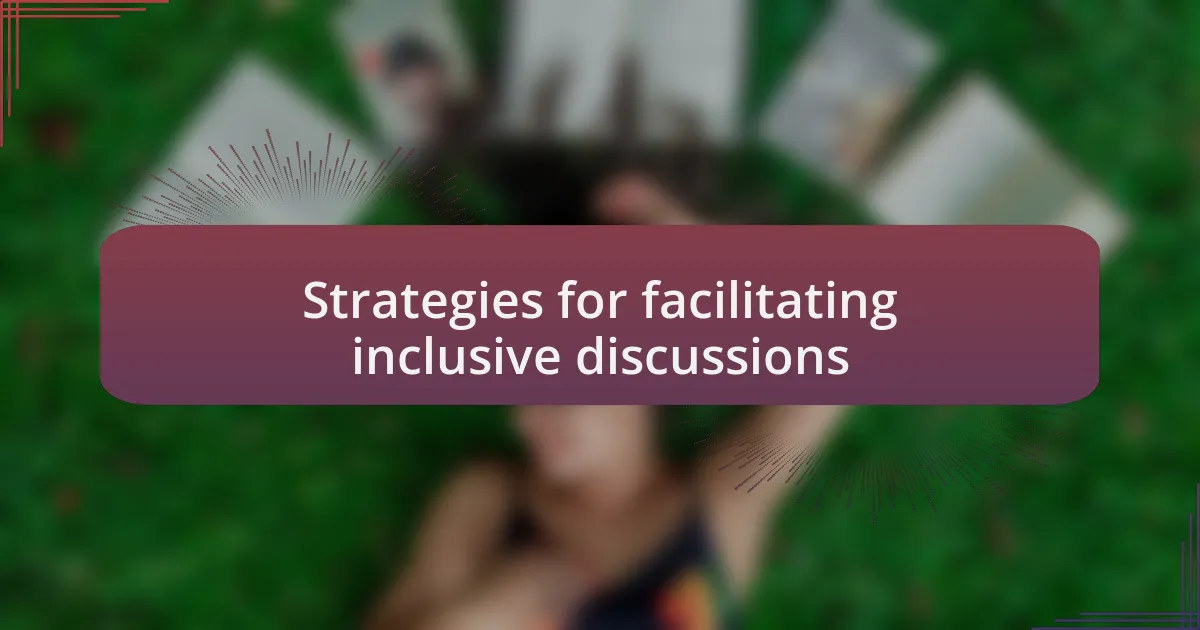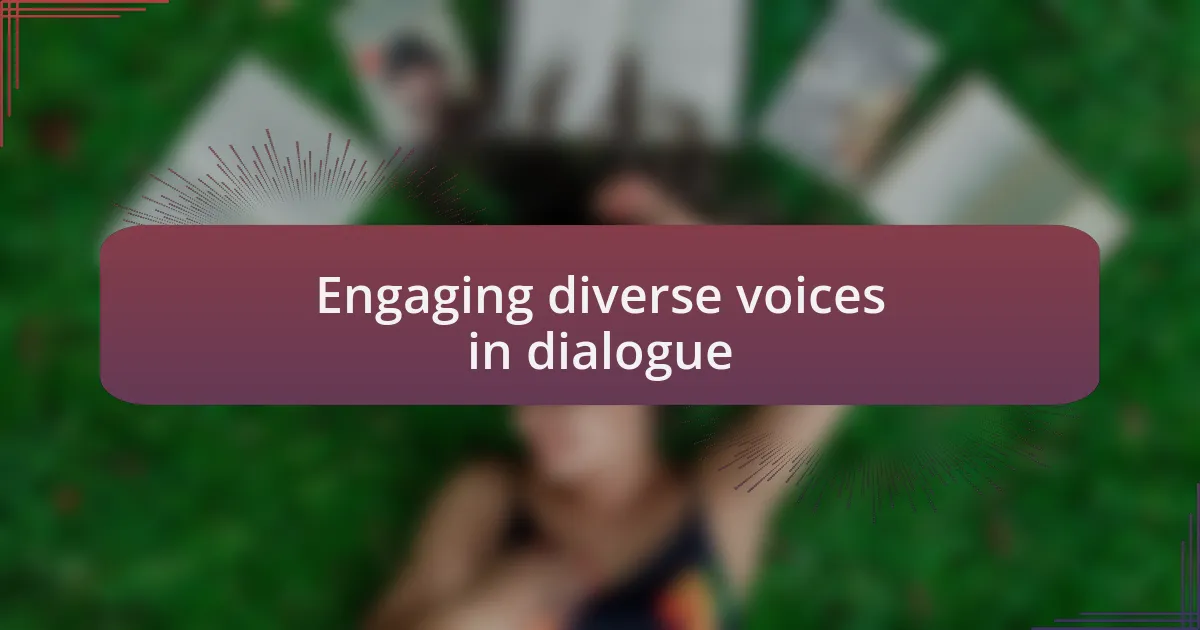Key takeaways:
- Inclusive discussions enhance understanding by valuing diverse perspectives and fostering empathy.
- Bookstores play a vital role in community building by showcasing varied voices and creating welcoming environments.
- Facilitating inclusive discussions involves setting ground rules, using thought-provoking prompts, and being aware of group dynamics.
- Active listening and encouraging feedback are essential for deepening engagement and making participants feel valued.

Understanding inclusive discussions
Understanding inclusive discussions means recognizing the diverse backgrounds and experiences that participants bring to the table. I remember a book club I attended where members had vastly different perspectives, but those differences sparked some of the most engaging conversations. Isn’t it fascinating how varied viewpoints can enrich our understanding of a story?
When we prioritize inclusivity, we create a safe space where everyone feels empowered to share their thoughts. I once facilitated a discussion about a controversial book, and as participants opened up about their interpretations, I felt a wave of empathy wash over me. It reminded me that behind every opinion is a unique story, and acknowledging that can foster connection.
Moreover, inclusive discussions encourage active listening, allowing each voice to be heard. I’ve seen firsthand how this approach can transform a conversation from a simple exchange of ideas into a meaningful dialogue. Have you ever felt that rush of excitement when a quieter member finally shares their insight? It’s a powerful reminder that every contribution matters.

Importance of inclusivity in bookstores
The significance of inclusivity in bookstores cannot be overstated. I recall a time when I walked into a local bookstore that made a heartfelt effort to represent authors from various backgrounds. It was more than just a business move; it felt like an embrace of diversity. When a bookstore showcases multiple perspectives, it invites readers to consider new ideas and helps counteract the tendency to stick with what is familiar.
Inclusivity also enhances community building within bookstores. I remember attending an author signing event that brought together readers from all walks of life. The conversations that sparked among attendees were surprisingly enriching. Isn’t it amazing how a shared love for books can bridge gaps between different cultures and experiences? That sense of belonging makes readers feel valued and more likely to return, fueling the bookstore’s role as a communal hub.
When bookstores prioritize inclusivity, they create a welcoming environment where everyone can find a piece of representation. I was amazed at how a simple display of + literature transformed my perception of an ordinary bookstore. It wasn’t just about selling books; it was about affirming identities and celebrating differences. What if every bookstore took that approach? It could change the narrative of reading as merely a solitary experience to one of shared understanding and mutual respect.

Strategies for facilitating inclusive discussions
Facilitating inclusive discussions requires intentional strategies that invite diverse voices to the table. One approach I’ve found effective is to establish ground rules that promote respect and openness. For instance, during a recent book club meeting, we agreed to listen actively without interrupting. This simple guideline transformed our conversations, allowing quieter members to share their thoughts, which they often held back before. Can you imagine how much richness we’d miss if only the loudest voices were heard?
In addition to setting rules, using prompts can significantly diversify perspectives during discussions. I often introduce thought-provoking questions tailored to the book we’re reading, aiming to connect themes to personal experiences. For example, while discussing a book on social justice, I asked participants to reflect on their own experiences with inequality. This sparked deep conversations that unveiled insights I hadn’t anticipated. It was a powerful reminder: sometimes, asking the right questions can open up new avenues of empathy.
Lastly, being aware of the dynamics at play during discussions is crucial. I’ve noticed how dominant personalities can unintentionally overshadow quieter participants. In my groups, I make it a point to invite quieter members to share their thoughts directly. By doing so, I’ve seen a transformation where everyone feels encouraged to contribute. Isn’t it remarkable how a small nudge can empower underrepresented voices to shine?

Creating a welcoming environment
Creating a welcoming environment begins with establishing a sense of safety for all participants. I remember the first time I attended a discussion group that focused on sensitive themes. The facilitator began by sharing her own vulnerabilities, which instantly made me feel more at ease. It struck me how openness can invite others to let down their guards. Have you ever noticed that when someone shares a personal story, it encourages others to do the same?
Another key element is physical space. I’ve often found that arranging chairs in a circle fosters a more inclusive atmosphere than a traditional classroom layout. In one instance, we gathered in a cozy corner of a café, which not only reduced the formality but sparked spontaneous, candid conversations. It made me realize how our surroundings can affect our willingness to engage. Can a simple rearrangement of furniture truly impact the quality of our discussions?
Additionally, acknowledging the diversity of experiences within the group can deepen connections. I try to take a moment at the start to celebrate the unique backgrounds of everyone present. Once, when discussing a novel that explored cultural identity, I encouraged members to share their own backgrounds related to the story. The richness of those anecdotes made our conversation unforgettable. How often do we overlook the stories that shape us, and how essential are they to building understanding?

Engaging diverse voices in dialogue
Engaging diverse voices in dialogue requires an intentional approach to listening. I remember a time when I facilitated a book discussion about a powerful historical narrative. One participant shared a family story that connected deeply with the themes of the book, prompting others to reflect on their own histories. It was a reminder that when we actively listen and respond to each voice, we foster a richer, more layered conversation. How often do we truly absorb what others share, rather than just waiting for our turn to speak?
Moreover, asking open-ended questions can invite deeper engagement from everyone involved. During a recent online reading group, I posed a question that encouraged participants to draw parallels between their personal experiences and the book’s themes. The responses ranged from poignant to humorous, creating a tapestry of perspectives that enlivened our discussion. I’ve found that sometimes the simplest prompts can lead to the most profound insights. Do you think inviting vulnerability can transform a standard discussion into a meaningful exchange?
Incorporating different media can also enhance the dialogue and reach a wider array of voices. I once included short video clips related to the book’s content, which sparked lively debates and unexpected connections. Participants felt more empowered to share their thoughts, reflecting on how visual elements had resonated with their own experiences. It made me wonder how much more we could achieve if we continuously sought ways to diversify our discussion tools. How can we explore beyond words to enrich our conversations?

Tips for active listening skills
Active listening is an essential skill that can genuinely transform conversations. I recall a time during a virtual book club where I made a conscious effort to nod and maintain eye contact, even through the screen. This small shift impacted how participants felt about sharing their insights. It made me realize how our non-verbal cues can encourage openness and connection. Have you noticed how a genuine smile or a slight lean can make someone feel truly heard?
Another effective tip is summarizing what others have said before offering your perspective. I remember a dynamic discussion about a contemporary novel where summarizing a participant’s thoughts led to a richer analysis of the themes involved. When I repeated their core ideas back to them, it not only validated their contribution but also encouraged deeper reflection from the entire group. How often do we take the time to reflect back what we’ve heard, rather than jumping straight into our points?
Lastly, resist the urge to interrupt or interject with your own experiences right away. In one of my online forums, I found that waiting a few moments after someone finishes speaking often yielded deeper insights. It allowed time for participants to elaborate, resulting in a more comprehensive understanding of the narrative being discussed. Could it be that patience in dialogue not only fosters respect but also deepens the conversation itself?

Encouraging feedback and sharing experiences
Encouraging a culture of feedback is crucial in any discussion space, especially in an online bookstore community. I once participated in a discussion group where we dedicated a section of our meetings solely to sharing experiences about our reading journeys. This practice not only made members feel valued but also helped us connect on a personal level. Don’t you think there’s something powerful in hearing how a book transformed someone’s life, even if it’s just a small detail?
On another occasion, I initiated a feedback channel where every member could suggest ways to improve our conversations. The surprising part was how many people felt hesitant at first. However, once they saw that their insights actually influenced future discussions, their engagement skyrocketed. It made me wonder: Are we truly aware of how sharing our thoughts can shape the community we’re part of?
Lastly, I learned that celebrating contributions, big or small, cultivates openness. I remember acknowledging a member’s brave contribution by sharing how their story resonated with my own reading habits. This simple act not only elevated their experience but also encouraged others to share more freely. In my opinion, recognizing each voice enriches the tapestry of discussions, making it more vibrant and inclusive. What have you done recently to make someone feel heard and valued in a conversation?